EQ Master Class (MC) is a powerful program that supports participants to Pursue their Noble Goals and become more successful as EQ change makers. Working closely with the Six Seconds’ team and a group of highly committed advanced allies, participants go deep into Six Seconds’ tools and methods. As we do in all Six Seconds’ program, MC blends head+heart+hands, using emotions and science to fuel transformation. To integrate & focus their learning, MC participants complete a substantial project — some of which are explained below.
MC is open by invitation to practitioners who have completed one of Six Seconds’ advanced EQ certification programs – facilitator, coach, or consultant. All are actively using the Six Seconds’ tools and methods, and many are Preferred Partners who’ve fully integrated these resources as a core of their work. Upon completing the Master Class participants can apply for the “Advanced Practitioner Certification” and become one of a handful of people in the world with this credential. To earn the certification, they need to define and execute a project representing 40-to-100 hours of professional work using the tools and programs from Six Seconds.
In 2018-19 we had an amazing cohort of EQ practitioners co-create a week of learning and discovery in Koh Samui, Thailand. Here is a window into their projects and impressions of the MC journey.
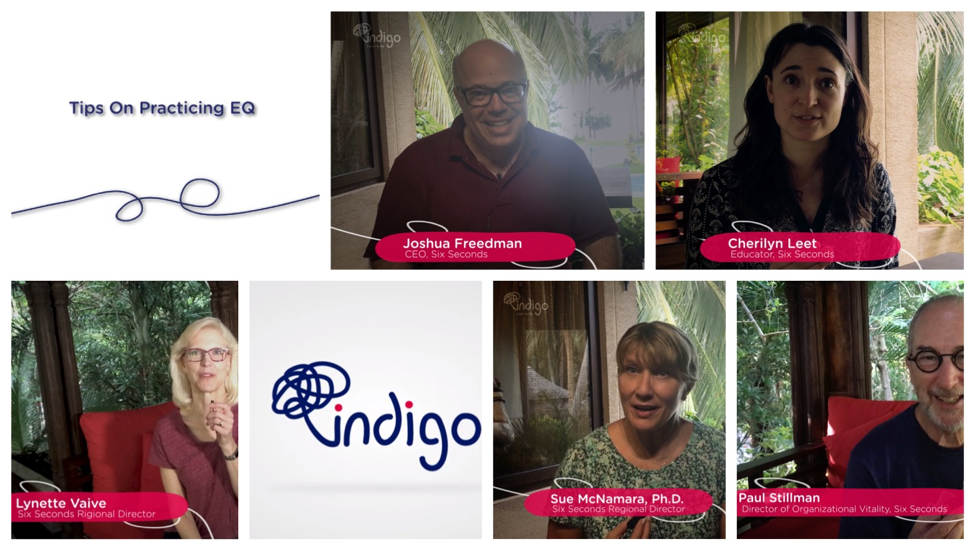
My initiative was to create Video Content on Emotional intelligence. The videos are designed to be a short and effective tool targeting people who are interested in growing their awareness about Emotional Intelligence by giving viewers access to first-hand knowledge from professionals, experts and practitioners in Emotional Intelligence around the world.
Sereen's Project
Project/initiative
Throughout my career as a certified trainer and a practitioner of Emotional Intelligence I was able to identify the need to simplify the ideology behind EQ and present the information and its usage in a more direct and practical ways in order for people to become more aware and knowledgeable of how to reflect EQ practices in their daily activities either professionally or socially. To do so, the design of the videos revolved around producing testimonial segments presenting experts and leaders in commanding possessions transferring some of their thoughts and practices of EQ usage in practical situations. With the completion of this project, people now have access to reliable information idirect and easy to understand on-line videos presenting tips and tricks from industry leaders on Emotional Intelligence showcasing how to deal with stress when things get complicated, how to become successful at what you do, understanding the meaning and importance of trust, how emotions mater, and realizing your noble goal.
Self-awareness, now a days, is increasing. People are always looking for ways to feel more comfortable. They look for ways be more aligned and to manage stress levels and keep it to minimum. The EQ on-line videos are a scalable, spreadable and effective tool to transfer the knowledge of EQ professionals and practitioners and present them in an easy and quick way acting as a reference point for the masses interested in having Emotional Intelligence playing a role in their life.
Why are you are doing this project?
In my experience as a trainer in Emotional Intelligence, I have realized the need to transfer the knowledge of EQ to more people using simplified EQ practices linked to practical actions. The idea of the project was to learn from the experience of experts and leaders in the EQ community and unleash the information they possess and understand how they use simple and practical EQ techniques in their daily life. Untimely, this project will help me fulfil my need to have EQ reach more people and will help me expand my knowledge by being in direct contact with experts on how to realize my personal awareness journey.
The on-line videos are designed to be a supporting tool for clients who are ready to make a change and searching for wisdom. The simplified information they offer makes them very effective in transferring basic EQ information, thus having a direct positive impact on clients as they minimize time and effort in explaining EQ concepts and maximize EQ benefits and usage.
This project has many elements that are aligned with my noble goal. The simplified technique of presenting direct and practical information makes these on-line videos easily transferable and in today’s on-line digital world this gives them a “viral status” element, allowing them to have great reach and penetrating more people; effectively delivering Emotional Intelligence to more people, thus achieving my noble goal to “Help People Reach Their Potential”.
How was MC for your growth?
The overall experience and process of the Master Class were amazing. I was able to be more organized with my plan and had forward thinking vision of the time line. The support I received from my mentor and group was of added value. Together, we were able organized ideas and put them into an action plan with a manageable time line. The MC offered a lot of support from either the sessions provided or the group which we were assigned to. On the one hand, and during group discussions, I was able to validate my ideas and/or identify minor issues that needed more attention. On the other hand, the sessions I attended were of great benefit and played a role in kickstarting the project. The information gained from all the experts during the sessions were excellent and very beneficial.
Realizing the number of experts and the amount of information available during MC intrigued me to take advantage of the situation and kick start the project during MC rather than later. This pushed me to act outside my comfort zone and move the project forward. With a proper action plan in place, this only meant that I start the project before schedule. Rescheduling pushed me to reach another one of my potentials I did not realize it existed in me, aligning all this experience with my Noble Goal.
The Master Class helped me a lot with my personal and professional growth. It introduced me to new tools. It gave me the opportunity to meet with all the experts from all over the world and gain from their knowledge and experience. I was able to hear new ideas and get exposed to more case studies. MC opened a lot of widows to me which I was able to utilize in my own work and benefit from the outcome. After MC, I was able to set my work plan on its correct heading in a more focused way by realizing how the experts do their actions and benefitting from their experience. Moreover, being in contact with such professionals in the field of EQ elevated my motivation and optimism. It ignited an internal spark in me that we are working all together for the same cause all over the world. MC made me believe more and practice more.
About Sereen:
“I feel privileged when someone allows me to join their awareness journey. It’s my greatest passion in life – to be a part of change for the greater good, a better future for all of us.”
Sereen Abu Maizar, Emotional intelligence Trainer and assessor.
Facebook: Sereen Abu Maizar wahbeh , Indigo_eq
Twitter: @sereenabumaizar
LinkedIn: Sereen Abu Maizar
Instagram: Sereenam

My project was to launch a new EQ business focused on developing women leaders. Leadership Shapers is a program designed to support female university students to be the best they can be. Starting from second year, participants will grow their emotional intelligence and leadership capability, joining a connected community that will partner with them as they complete their studies, enter the workforce and progress in their careers. Whilst the key participants will be the students, there is a broader audience in our businesses and mentors.
Amanda C's Project
Project/initiative:
Leadership Shapers is a program designed to support female university students to be the best they can be. Starting from second year, participants will grow their emotional intelligence and leadership capability, joining a connected community that will partner with them as they complete their studies, enter the workforce and progress in their careers. Whilst the key participants will be the students, there is a broader audience in our businesses and mentors.
This program is an opportunity to highlight EQ and leadership skills as foundational for performance and success. Businesses will benefit through recruitment of graduates who have self-awareness and tools for personal growth. The mentors in the program will be able to give back through sharing their own experiences and enhancing the lives of a new generation.
Phase 1 of the program starts with a Survey of Emotional Intelligence (SEI) debrief, followed by a series of experiential workshops.
The four workshops will include:
• Growing EQ (2 competencies per workshop)
• Brain profiling and understanding of brain styles and talents
• Mentoring – sharing real life stories and experiences
• Group Coaching – tackling the challenges specific to the cohort
• Connection – for ongoing support and knowing that they are not alone
The students become a member of a community of peers, mentors, coaches and organisations who value the development of Emotional Intelligence. Phase 1 concludes with an event to bring everyone together to celebrate and reflect. There will be a final measurement to allow for comparison and analysis (Dashboard or Group Report).
Phase 2 will be available to third (and fourth) year students wishing to grow their leadership capability. We will use the Vital Signs model to train in leadership and Phase 2 students will become mentors for students in Phase 1 and participants will be paired with their own mentor.
Why are you are doing this project?
My project commitment was to run focus groups. One was with young women in their mid/late 20’s. I was trying to establish whether an EQ and leadership program at university would have been of interest to them. The response was a resounding “yes”. They spoke of their challenge in navigating through applying for their first jobs, of “falling” into a job because that was the internship they could get, of not really knowing what they wanted to do…and through it all, not knowing where to turn for support. They were saying this with the benefit of hindsight; at the time, they were blissfully unaware of what lay ahead. I want our young women to hit the ground running when they enter the workforce, for them and for the broader community. We need to find a way to unlock leadership potential – just look at the global landscape. I see our young women as an untapped pool of potential.
My noble goal is to connect people to their potential, so this program and business are perfectly aligned for me. I have two daughters and would love for them to be entering the workforce with confidence, resilience and the EQ to achieve whatever they set their minds to. For me, it is an opportunity to connect to my own potential – I am creating a new business and I’m excited by the challenges I know I will need to navigate.
Overarchingly, I believe I have an opportunity, perhaps even an obligation, to use my knowledge and experience to improve others’ lives, which I hope will include, not only the students who participate, but also the mentors who will support them, the coaches who will help me deliver the program and the businesses who I want to take on the journey.
How was MC for your growth?
The Master Class (MC) Process MC gave me the accountability and support to bring my project to life. The concept was there and having the opportunity to team with a mentor who encouraged and stretched me saw the project evolve from a concept in to a whole new business. Without the MC process, I don’t believe I would have set up a company, recruited the first members of the Leadership Shapers community and be running a pilot program as I conclude the MC program. I’m sure I would have made it there eventually, but then again, perhaps it would have stayed only a concept. MC, apart from the community of support and encouragement, expanded my thinking on the ways I could deliver the Leadership Shapers program.
During the week at MC, each session I attended gave me a new idea I could incorporate into my business, whether specifically around the program content and structure, or how to brand my business and sell EQ. More broadly, my work as an Executive Coach and Facilitator has evolved. I often reflect back to MC for inspiration on how best to support my clients in their pursuits. Increasingly, my clients are exploring their own Noble Goals, and I’m often reminded of the heart talks each of us gave to paint the real-life pictures of how EQ weaves into every aspect of our existence.
Being able to blend the experiences from MC into workshops with my clients is both fun and produces amazing outcomes. Finally, there is the amazing legacy of the MC cohort…a wonderful group of like-minded, EQ-motivated, smart and capable human beings, who continue to support and encourage each other and who I hope will always be a part of my life and work.
About Amanda:
I am a passionate Executive NeuroCoach who has infused the Six Seconds tools, frameworks and philosophies into all I do. I have a corporate background and am now excited to be forging my own way. I face the daily challenge of juggling work I love and raising three young children.

My project is a new offering to combat workplace stress: The Better Workplace Community Program, a mix of experiential learning and practice, via community, group, face to face and online delivery. Informed by the research-backed tools and methodologies of the Six Seconds EQ Network.
Karen's Project
Project/initiative
The Better Workplace Community Program
The Better Workplace Community Program (Program) provides the opportunity for business owners and key staff to learn the skills and practices needed to successfully lead their businesses now, and into the future
Why are you are doing this project?
Participants apply to be a Member of the Program because they are tired of losing sleep over workplace issues. They’ve experienced increasing workplace stress, the cost of getting ‘it’ wrong, and they know their business success hinges on them growing their ability to empower themselves and their people to get ‘it’ right. They acknowledge success comes when they, and their people are more empowered, productive and purposeful. Through this Program they learn that people high in EQ are 10.2 x more likely to have high outcomes1, and how to make EQ practice a part of their day to day personal and professional lives.
Engage
Potential participants hear about the Program via a series of lead bait articles that ask ‘What makes a better, productive, and innovative workplace?’ Current client case studies will demonstrate the value add of embracing EQ.
Activate
The Program is a mix of experiential learning and practice, via community, group, face to face and online delivery. Informed by the research-backed tools and methodologies of the Six Seconds EQ Network, and other credible tools, participants will learn through doing:
- Community functions and workshops
- SEI and or TVS, Brain Talents assessments and debriefs
- Group and 1:1 coaching
- Employee lifecycle essentials
- EQ development
- Exploring how to manage tricky people and culture matters
The secret of getting ahead is getting started.’ Mark Twain
Reflect
Participants – End of Program assessment and debriefs will provide clarity of Program wins. We will also ask check, ‘What Now/1, 2 years from now?’ This will be followed by a celebration of progress. An aftercare approach, with a check-in ‘how are you?’ phone call at the 12 month post program date will provide the opportunity for past participants to assess how they are tracking against goals, and if new support is needed.
People Alignment – Our experience in the Program, client feedback and referrals will inform our reflections.
Since starting People Alignment in 2011, I’ve seen first hand, a pattern of poor communication, uncertainty and stress in workplaces. The State of the Heart Report confirms that stress is on the rise, and Reventure have found that more than half of all Australian workers agree increasing change and complexity are leading to disengagement and high levels of stress at work2.
Most business owners say managing people is the most stressful, costly and time-consuming aspect of their business. But this is often because businesses invest in Marketing, IT, Finance and sometimes Strategy3, but rarely quality People and Culture expertise. The result is poor organisational health, and a lack of expertise to:
- accurately determine and describe who and what potential they need to attract into their business
- onboard people so they are set up for success
- create conditions where people are well, content, productive, creative and innovative
- retain their competitive advantage/IP and therefore business sustainability
These businesses face an uncertain future, and while those internal risks are having an impact, the external risks such as technological and demographic changes pose an even greater threat. By 2030 demand for skilled workers will outstrip supply, resulting in a global labour and talent shortage of more than 85.2 million people. This talent crunch as a % of the economy is the most pronounced in the APAC region4. The Centre of Excellence in Population Ageing and Research also confirms unprecedented changes to our labour markets, in ways never seen before5. Simon Sinek rightly explains that you can’t ward off external risks if you have internal risks6.
“Unprecedented, pervasive, enduring, profound. There is the possibility of labour markets changing in ways that they never have before.”
John Piggott Centre of Excellence in Population Ageing Research
It will take more than $s to attract, retain and engage the right people for business prosperity7. Thanks to the efforts of researchers we know what to do. Read on to find out more.
w PROGRAM IMPACTS
This Program aims to provide a learning environment that create the following impacts:
|
IMPACTS |
CLIENT |
PEOPLE ALIGNMENT |
|
Workplaces get people into a Smart State and prioritise safety, mattering and belonging8. Business owner ability can stretch capability through powerful coaching conversations and approaches that keep people in a towards/reward state9.
|
Noble Goal + Building a funnel of work. |
|
|
New insights, imbedded learning, access to validated frameworks, methodologies assessments, literature. |
Noble Goal + Case studies |
|
|
Employees are working in a workplace that priorities EQ, and enjoying successes like L’Oreal’s spike in sales and the US Air Force’s savings from using EQ development10.
|
Noble Goal + Connections |
|
|
No longer alone, connected. Opportunity to create rich, collaborative relationships.
|
Noble Goal + Learning
|
How was MC for your growth?
What I enjoyed most about MC was being in the bubble and connecting with a global community of highly experienced positive change experts. The relationships were forged mean I have people I can call on, and I’m enjoying supporting this community where I can too. Doing so in the gorgeous venue was the icing on the cake. The timeframe was perfect. At first I didn’t think 6 months was necessary, but it was really interesting, useful and valuable, to have that extended period of time. I found gems would come through even in the last couple of weeks, and they would have been missed had the timeframe been shorter.
Since MC I am continuing my growth around how to create fun, yet impactful communities of learning. I’m now translating that across the businesses I currently work in, extending timeframes and varied ways for people to capture their own wisdom. My stretch challenge of creating a business support forum in taking shape, and I am hoping to launch it mid-year.
Top 10 MC gems
- the diversity of the group – in the land of down under, Australia, there are few opportunities to mix with diverse cultures
- getting to know the network leaders
- sharing contact details, and knowing there’s a group of us on this journey
- the heart talks –a powerful way to see EQ in action
- the generosity of the staff – Liza’s pilates, Maria’s yoga, Tom’s guitar by the pool into the wee hours, Josh and Patty sharing their own room for sessions, Jayne’s session on the Hummingbird Leadership Program, and wine
- exposure to other Six Seconds initiatives
- being assigned a marvellous mentor in Marilynn
- picking up awesome tips and tricks for imbedding learning – Susan’s activities
- being in the bubble of growth, community and fun
- the support, information and accountability to pursue my project
ABOUT Karen
I am Mum to Sarah and Curtis, who are both getting established in their careers – yay! Wife to Angus, busy business owner, lifelong learner and loyal friend. A Bon Jovi tragic who enjoys staying fit, walking in nature, reading and relaxing at the beach. I have simple pleasures, a glass of wine with good friends and living my noble goal of helping people be more empowered, productive and purposeful in what they do.
Website – www.peoplealignment.com.au
Linkedin – https://www.linkedin.com/in/karenmuggleton/
=====================
- REFERENCES
- State of the Heart Report 2018
- Our workplaces are more stressed that ever. https://www.headsup.org.au/training-and-resources/news/2017/09/26/are-our-workplaces-more-stressed-than-ever-before
- Lencioni Patrick (2012). The Advantage: Why Organisational Health trumps everything else in business. Jossey-Bass. San Francisco. CA.
- Korn Ferry Group Pay Forum 2018
- John Piggott Centre of Excellence in Population Ageing Research
- Sinek, Simon. (2016) Leaders Eat Last.
- 2018 Salary Guide Robert Half
- Comaford, Christine. (2013) Smart Tribes: How Teams Become Brilliant Together. Penguin Group (USA) Inc. New York, NY, USA.
- Rock, David. (2006) Quiet Leadership. Six Steps to Transforming Performance at Work. Harper Collins. New York, NY. USA.
- Emotional Intelligence: The Business Case. Six Seconds The Emotional Intelligence Network. Joshua Freedman and Paul Stillman
- TOOLS
- Survey for Emotional Intelligence
- Survey for Emotional Intelligence 360
- Vitals Signs – LVS, TVS or OVS (depending on need)
- Brain Talent Profile
- SEI Group Report (when applicable)
- Referral to Certifications
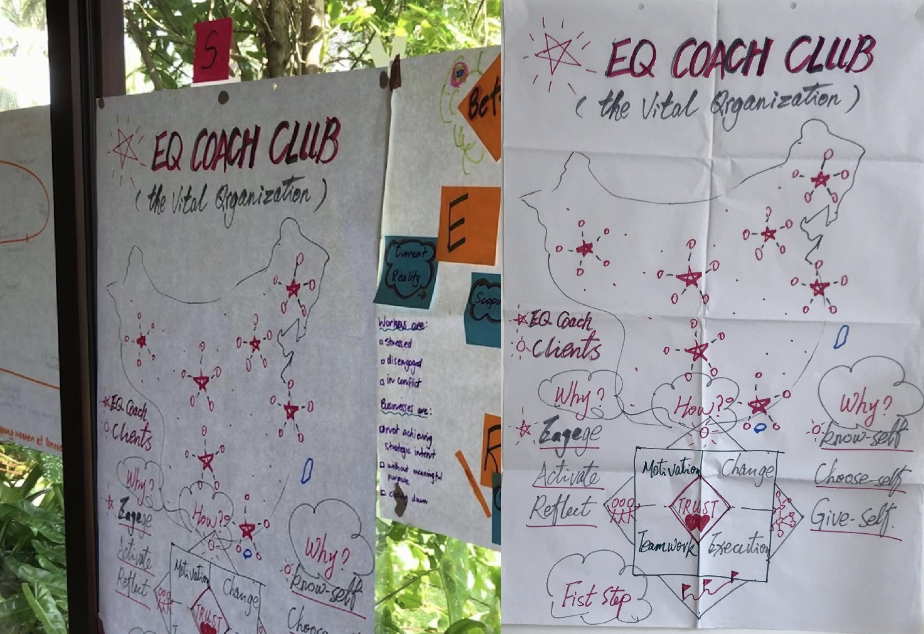
My initiative was to create EQ COACH CLUB to build a bridge between new coaches and real clients. With their membership in the Club EQCC students in China will keep growing in their practice, achieve a sense of accomplishment, and feel more confident to become a professional coach.
Sandy's Project
Project/initiative
EQ COACH CLUB can build a bridge between new coaches and real clients. With their membership in the Club our EQCC students will keep growing in their practice, achieve a sense of accomplishment, and feel more confident to become a professional coach.
Our audience is professionals, who are facing stress and challenges including: career development, life goals, business problem, leadership, relationship, wellbeing and balance. They seek greater awareness, to be more purposeful, and find the ways and energy in the face of challenges; They wish to enhance positive changes in life and career.
Professional members are new coaches, who are practicing what they learned from EQCC without enough experience and confidence. They wish to reach out to real clients and grow in their practice; They are looking for professional guidance to enhance their coaching skills, and feel more confidence.
Participants will have the opportunity to develop courage to confront their emotions through coaching session or observing coaching demo. They can stay aware of their reactive patterns and operation system under emotions, and connect their internal potential in order to uncover patterns, and achieve positive changes. Participants will also be exposed to Know Yourself, Choose Yourself, and Give Yourself in the most straightforward way by using EQ Tools including EQ Coach Card, TFA Card, Talents Card, Ice berg, etc.
The first phase of the EQ Coach Club salon will be held both in Beijing and Shanghai in February 2019. We will summarize and reflect on the first practice, and give helpful supervision. Starting from March, our EQCC coaches will hold salon every month in 6 provinces and cities within China mainland. Each coaching session in above activities will be recorded. We will also organize and publish these real cases in order to affect more people to know and benefit from EQCC.
Why are you are doing this project?
As a Priority Partner of Six Seconds, I would like having more people to experience the unique charm of EQCC, which is helping clients to know themselves in-depth with the most extensively usage of EQ resources, and further to break the restriction to gain methods and energy of positive changes
My noble goal is “Helping more people to connect with their true selves, tapping their potential, and achieving a free and glorious life”. EQ Coach Club is a self-development win-win system, which can help more and more professionals and coaches to be freer souls and more successful in careers. As a result they may feel valued and driven by their purpose.
How was MC for your growth?
What is one way the process helped you go further/faster that you could have otherwise?
Within the MC process, we are divided into different seminar group with a mentor in each. Marilynn, our mentor, is very gracious. She always asks us about our process and thoughts patiently and carefully during group counseling period. In the meantime, she will ask questions helping me to understand the project plan. I might have learned a lot, but without such a mentor, without her supervision, my project won’t be completed on schedule.
I found myself especially touched by the Global EQ Network. Even though my English is not that fluent and sometimes I can’t fully understand what they said, I could feel the sincerity, care and goodwill, and it was very touching when I was communicating and discussing with partners of different color and language. At the same time, I feel very proud to be one of a community with great vision. These also fortify myself to go with it as a EQ coach.
About Sandy
I’m a Professional Coach with 7 years experience. I help managers developing their leadership by training and coaching, and I love to help new coaches developing Coaching competencies as an EQCC mentor coach. And I’m so proud of being a Priority Partner of Six Seconds in Coaching Area from 2018.
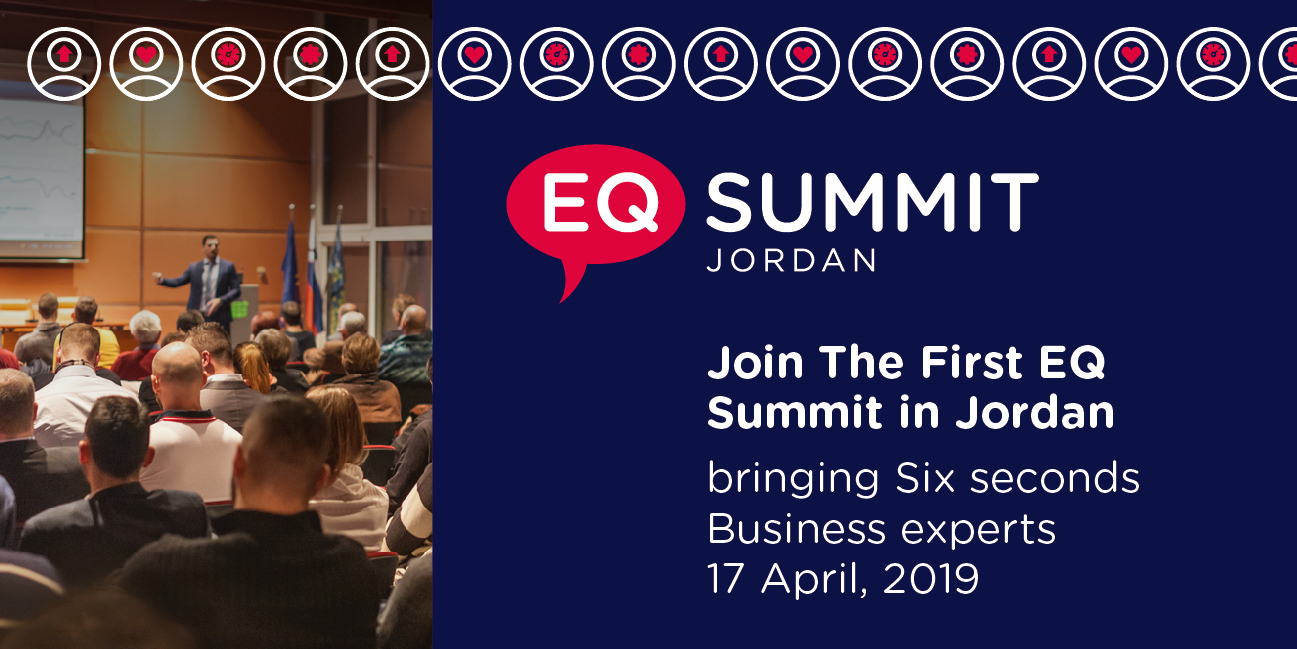
My project is to create an EQ Summit in Jordan to expand the EQ business in our region. At the conference, experts will have the chance to find answers that work with people, based on real life situations and practical proven measurements, they will engage with real world cases not only theories, have the chance to carry meaningful dialogues with EQ experts and practitioners.
Manal's Project
Project/initiative
EQ Summit Jordan, April 17 2019, is bringing in experts from within the six seconds community to share their insights, researches and the tools developed to assist the various business environments in a one day interactive event filed with discussions about the latest theories in Emotional intelligence and their relation to business outcome,.
Through the summit business experts will gain vital insights into the learnable, measurable, scientific skills of emotional intelligence and how they create value. They will discover the latest research, break-through tools, case studies and proven best practices for EQ in business.
Join and share in proven approaches for putting EQ into action to increase effectiveness, improve wellbeing, strengthen relationships and improve outcomes.
By attending EQ Summit Jordan business experts “HR professionals, L&D professionals, Business Consultants, Team Leaders, Managers” will have the chance to dialogue with the leading Emotional Intelligence experts from within six seconds network. They will join global experts at the forefront of emotional intelligence practice for Organizations, Teams, and Leaders.
During the EQ Summit, experts will have the chance to find answers that work with people, based on real life situations and practical proven measurements, they will engage with real world cases not only theories, have the chance to carry meaningful dialogues with EQ experts and practitioners.
In addition they will have the chance to seize this rare opportunity to connect with well-known practitioners and scholars with decades of proven experience developing and applying emotional intelligence around the world.
Why are you are doing this project?
Our goals for this project:
- Highlight the importance of emotional intelligence and the relation it has to the different self-development sciences, approaches and practices.
- Branding for Six seconds in Jordan.
- Branding for Indigo.
- Tying Indigo with six seconds as the preferred partner in the MENA region and the soul representative in Jordan.
Jordan has been identified as a country in need of intense support for strengthening the mental health system. It was chosen as the first country to implement World Health Organizations’ mental health action program (mhGAP) from among six countries across the globe. We want to bring together experts in different areas in EQ to touch on different issues that would support emotional health inside business environments. Speakers are going to be from different backgrounds. We will discuss the impact of the different aspects of emotional health on human performance.
I’m using my Noble Goal help me on this project: “Creating collaborative, energetic environments where every individual can overcome obstacles and reach their full potential.”
The Summit is all about building a strong network for an agile community that practice EQ in every aspect of their daily life. The summit will bring in real life practices to the business environment and support professionals to boost their personal capabilities alongside the capabilities of their teams to overcome their personal obstacles and achieve their optimal potential.
How was MC for your growth?
Working closely with my mentor Jim Vaive gave me the confidence needed to proceed with my project…holding a summit with this size in Jordan, with Indigo only two years in business, is a big challenge for myself and the team, especially with the economical situation in the area.
In addition, Jim supported me in seeing the business value behind the Summit, made me reflect on how to achieve the required keeping my company’s needs and the clients’ needs in perspective.
The reflection on my LVS report supported my leadership skills, currently I am working closely with the team to elevate their participation level, I am practicing delegation with full empowerment more often and I am navigating my emotions when in office “especially the fear emotions I carry for this huge task”.
Keeping my Noble Goal in mind guided me to select my target audience and channels carefully, concentrating on agile and energetic environments led my choice to targeting the Summit to business audience. Even it is giving me the required motivation needed when I am at a business meeting promoting for the Summit and it’s anticipated impact.
In addition, the interaction with the different expertise that was available during the MC offered me various perspectives and business models to learn from and reflect upon. The sessions I attended at the MC broadened my perspective for different EQ applications inside the business environment.
About Manal:
Continuously driven to ensure that Indigo is meeting the individual needs of every participant that it works with.
“My mission is to support individuals to grow, at their own pace and within their own capabilities. My passion is creating collaborative, energetic environments where every individual can overcome obstacles and reach their full potential.”
Website: http://www.eqsummitjo.net/
Facebook: https://www.facebook.com/events/343247796518413/

My project is to create One-Day workshop for Leadership Using the VS Model. We have a demand for a leadership program but it is not easy to link it with EQ. – This program will make the leaders to understand the importance of five drivers without assessment tools. – I want to make the participants want to go to the next stage of assessment vital signs and SEI assessment.
Woochoon's Project
Project/initiative
My project is to create a leadership with EQ program for my company Root Consulting. We have a demand for a leadership program but it is not easy to link it with EQ. – This program will make the leaders to understand the importance of five drivers without assessment tools. – I want to make the participants want to go to the next stage of assessment vital signs and SEI assessment.
Why are you are doing this project?
We work with Leaders who are struggling to achieve Performance. This new initiative is designed for the leader who is currently in charge of the team, candidates for Leaders. We want to have leaders reflect: What is my current level of leadership? – In what areas can I develop and grow leadership? – What fuels key performance indicators?
In this Leadership with EQ program, clients will share understanding of “leadership” and the key responsibilities for people-leaders. – They will recognize the factors that determine performance. – They will learn five drivers that affect leadership and focus on enrolling people in change. – They will plan to develop the drivers to strengthen leadership and improve Performance. Communicate why you are doing this project –
My Noble Goal is “Share the joy of growth with those who want to change, Help people to wake up and create a spiritual mature society.” Understanding themselves and developing leadership are all journeys of change and growth.
How was MC for your growth?
One of the most important tools I activated at MC was the EAR Process. It is very useful to use the EAR process to learn new things and to apply and develop them in life.
I was able to meet many experts, and was greatly inspired by their actions and existence itself. I have come to look back on whether my own actions and existence are suitable as professionals, and have Motivated to self aware and develop myself more.
I’ve been changed by the MC process. I came to think the quality of work as well as the quality of action and speech. I realized that other people’s feelings were all precious and connected to the whole. The capacity to accept the pain and agony of life has increased.
About Woochoon:
I have a passion for new discoveries and sharing especially in Human Growth.
My vision is to help people wake up and create a spiritual mature society.
My mission is to become a growth model to my members and grow my company into a Vital organization.
I live in Korea with my beloved wife, son and daughter and I’ve been running an HRD consulting company for 19 years.

My project is opened to everyone to join. I am creating a virtual EQ School for people to find a safe space for emotional stories. People can stories, find new friends with similar experiences, and have more chances to learn from talking and listening.
Wissen's Project
Project/initiative
My project is opened to everyone to join. Because I am leading a virtual EQ School for them to find a safe space of their emotional stories. They could share their stories, finding out a few of new friends with similar experiences, and have more chances to learn from talking and listening. I, sometime act as facilitator, sometime as EQ and stress management trainer, could share them my knowledge and experiences from my life-learning.
Why are you are doing this project?
First of all, I trust they do work because I am benefited by those ways. Thus, I am willing to follow those ways to help those who I could meet in my life. That do let me think of my NG – enable the world fall in love with stress! What’s the 1st step is right the space of willing to talking about their stories behind emotions. Then they need EQ competencies to change their life better on.
How was MC for your growth?
More volunteers with the same vision joining this project is the only way could help go faster, however my passion is the only way for going further.
During the MC, the effective tools such as VS gave me more confidence on my project. As my first experience of being in MC, now that’s so great for me. My growth must come from those who need the project and tell me they got!
About Wissen:
An EQ practitioner and coffee pot
LinkedIn: Wissen Wu

My project is to write a reflective paper that investigates several Six Seconds’ competencies. The goals within this piece of work are: (1) to draw on literature in support to my argument that emotional intelligence brings practicality to the concept of fixed and growth mindsets and (2) to propose new elements to three of the competencies within the Six Seconds model.
Larisa's Project
Project/initiative
My project is to write a reflective piece that investigates several Six Seconds’ competencies. The goals within this piece of work are: (1) to draw on literature in support to my argument that emotional intelligence brings practicality to the concept of fixed and growth mindsets and (2) to propose new elements to three of the competencies within the Six Seconds model.
Why are you are doing this project?
In 2017, I had the privilege to attend and speak at the World EQ Summit in Dubai and Mumbai. During the events, my message on how I see emotional intelligence was consistent. When asked to describe EQ in one word, I chose disruptive.
In exchanges with colleagues and participants, I offered that in my view, emotional intelligence represents a lifestyle – a way of being in the world and within its systems: family, social, work, business, etc.… Within the business space, I noticed new buzz concepts: fixed and growth mindsets, unconscious biases, collaboration, agility and strategic intelligence.
Reading on the topics, I built two hypotheses: (1) all these concepts have at core emotional intelligence principles and (2) emotional intelligence, mainly through the Six Seconds Model, can provide practical ways to bring these concepts to life. While emotional intelligence has been identified as a top skill for 2020 by researchers at the World Economic Forum, I have not yet heard of many organizations employing emotional intelligence to its full potential as a way of being in business or as an enabler for 360º performance, from operations to strategy, from people management to customer centricity.
Since the beginning of 2018, I have focused on learning and building my understanding of mindsets. Dr. Carol Dweck’s extensive research in mindsets proposes that the view you adopt for yourself impacts how you lead your life. This view also can determine whether you become the person you want to be and accomplish the things you value. (Dweck, 2017) Referring to the fixed mindset, she offers that it creates an urgency to prove yourself over and over – mainly if you believe that you have only a specific amount of intelligence, a certain personality, and moral 2 character. On the growth mindset, Dweck proposes that it is based on the belief that basic qualities can be cultivated through efforts, personal strategies and support from others. Even though people may differ in their initial talents, aptitudes, interests, or temperaments- everyone can change and grow through application and experience. (Dweck, 2017) What is important to highlight is that everyone has both fixed and growth mindsets. You don’t gain a growth mindsets by declaring it, you take a journey towards it. When working with clients on their SEI, I tend to use a complementary language. I offer that SEI scores don’t label you. It is not only about how you ‘score’, it is more about what you choose to do with the data and how you want to go about practicing the insights it provides.
I find the mindsets work fascinating and I feel that three competencies within the Six Seconds model can support with practicing a growth mindset: (1) Recognize Patterns, (2) Engage Intrinsic Motivation and (3) Exercise Optimism. At this stage, my hypothesis is based on my experience and learning.
In parallel to this Master Class project, I am conducting a quantitative piece of research that looks at the potential correlations between mindsets and the three competencies. More details on this can be found at point 4 – Active experimentation. For the Master Class project, I will focus on my personal reflections and my proposal for further exploration within the Six Seconds community.
I would like to briefly share how I channeled my attention on the three competencies. In one of the programs I attended last year on systemic coaching, one of the professors mentioned that if we give the same advice three times to three different clients, it is most likely an advice we give ourselves. Not within coaching, however in exchanges on emotional intelligence, I caught myself emphasizing a lot (1) the importance of building self-awareness through the understanding of productive and unproductive patterns of behaviors (I was working on building healthier boundaries); (2) the relevance of understanding the peculiarities of motivation in the context of testing assumptions (I have difficulties with praise in public); (3) the importance of language as it clothes our thoughts (I tend to be optimistic when it comes to others and more pessimistic when it comes to myself).
In the process, I noticed similarities between the three SEI competencies and mindsets. While mindsets have been widely explored within education, not much has been done within the business context. Derler et. al. note that while the idea has been spread like wildfire across forward-thinking organizations, it has been understudied in the field – until now (Derler, et al., 2018). Reflecting on my own experience, I know that working on the three skills helped me to progress towards a growth mindset.
Below I will look at each of the three competencies, as explained within the Six Seconds literature and as understood by me within the mindsets literature.
(1) Recognize Patterns D’Souza offers that pattern recognition enhances emotional intelligence by making it easier for individuals to communicate (D’Souza, 2011). When encountering new experiences, our brain processes the new information by comparing it to past experiences. In case of an overlap or familiarity, our brains take the convenient step of responding like it did before. Joshua Freedman notes that this competency helps you predict own reactions so to avoid being driven by unconscious habits (Freedman , 2007). He proposes that recognizing patterns is key to ‘mindfulness’ and that learning to observe a reaction in process is critical for understanding our emotional drivers. Observing yourself or others with no judgement and avoiding to reach a conclusion of what’s good or bad are key aspects to bringing this skill to life. This approach feels to be in alignment with Dweck’s take on mindset change which she describes as the shift from a judge-and-be-judged framework to a learn-and-help-learn framework. (Dweck, 2017) Recognizing patterns may be met with resistance by people who operate from a fixed mindset. Dweck notes that the fixed mindset has made a flaw intolerable, so admitting that you may have some work and learning to do may not land well. Fixed mindset people look for their talent to carry them through and see themselves as finished products, rather than work in progress. (Dweck, 2017) Dweck remarks that for people with a fixed mindset it is about being perfect right now. On the other side, for people with a growth mindset, it is not about immediate perfection. For them becoming is better than being. It is about learning something new, confronting a challenge and progressing. (Dweck, 2017) Brené Brown speaks extensively about perfectionism in her writings. She notes that perfectionism is not about healthy achievement and growth, yet it is a self-destructive and addictive belief system. It also does not equal self-improvement. (Brown, 2015) Within the mindsets space, Derler et. al. highlight that the evolution towards a growth mindset can be uncomfortable, with difficult emotions as part of the learning process. Where the learning may conflict with a person’s self-image, they may feel uneasy. Further, if this self image clashes with the person’s or others’ expectations, it may lead to emotions such as agitation, fear, or threat. (Derler, et al., 2018) Working on recognizing patterns can be the practical model that could enable new personal insights into a person’s relationship with their own emotions and the triggers these bring to them.
By exploring the SEI Model and the current literature on mindsets and taking into account my encounters with these two concepts, I see how they can enable each other. While at this stage, this represents only a hypothesis, I hope my current research in the space can bring additional information. Meanwhile, I believe it may useful to broaden what patterns refer to as found in the Six Seconds framework. Are the terms of patterns, schemas, unconscious biases interchangeable? Does one of them cover the other two? I believe within the Six Seconds community we can support with this.
In 2017, while taking an applied neuroscience programme, I came across the following definition for a schema: “A schema is a framework that helps us to organize and interpret information. It is learnt through experience and it is culturally driven. It acts as a shortcut to allow us to interpret the vast quantities of information that we receive and remember each day. Our stereotypes for people from a particular group are schemas.” Does this then mean that stereotypes are schemas? The work of Daniel Kahneman around the Fast Thinking and Slow Thinking systems provides new understanding on unconscious biases. These seem to be part of the Fast Thinking system or System 1. Subconscious processing of information is fast and relies on matching to previous patterns based on past experiences to draw conclusions about potential actions. Unconscious biases are implicit, associative and stereotypical. Does this mean that stereotypes are unconscious biases?
Within the Six Seconds space, patterns are looked at as combinations of thoughts, feelings and actions, which perhaps provides a more accessible way to explore this behavioural dimension. I wonder if clarifying these distinctions may be helpful in enabling people to practice more the skill of recognizing patterns and cultivate a growth mindset?
Engage Intrinsic Motivation In At the Heart of Leadership, Freedman proposes that Engage Intrinsic Motivation stimulates you to discover and engage the lasting inner motivation that lets you make change and grow. Intrinsic motivation enables you to persevere even when you encounter discomfort or embarrassment. It requires to reframe your thinking from “What will others think?” to “What is right for me?”. (Freedman , 2007) An interesting parallel is to be found in the mindsets literature. When discussing the relationship between mindsets and success, Dweck offers that the top is where fixed mindset people hunger to be. For growth mindset people, the top is where they arrive as a by-product of their enthusiasm. This is a clear example of the differences in nuances for extrinsic motivation (top, outcome, view on success) and intrinsic motivation (enthusiasm as fuel). Freedman also notes that finding our intrinsic motivation is one of the fundamental quests in life and proposes that the basis of intrinsic motivation and eventually happiness is to pursue things that captivate us and boost our mood by absorbing our focus and attention. (Freedman , 2007) Intrinsic motivation is a drive that begins from within and is about intangibles and personal values. When people are able to move from extrinsic to intrinsic motivation, the results, according to the psychologist Mihaly Csikszentmihalyi, is a state of ‘flow’. (D’Souza, 2011) In Flow, we achieve our creative best when performing a task because we are passionate about it. In his book named in fact “Flow”, Csikszentmihalyi offers that in order to achieve optimal experiences, we need energy and often we are unable or unwilling to put out the initial effort.
The practice of engaging in intrinsic motivation seems to support, at least as a hypothesis, the shift towards a growth mindset. It also seems to require personal effort and energy. Discussing perspectives on talent, Dweck shares that in the fixed mindset, great geniuses don’t need help as they rely a lot on their talent. Also, they don’t take control of their abilities and motivation. For people in the growth mindset, it’s quite impossible the concept of wanting something, thinking they have a chance to achieve it and do nothing about it. (Dweck, 2017) This gets strengthened by Csikszentmihalyi who mentions that innate talents cannot develop into a mature intelligence unless they learn to control attention. When we engage in intrinsic motivation, we tap into the core drivers that make us unique and strong – we find our energy. Rather than reacting and guessing about others, intrinsic motivation is internal, reliable, and full of integrity. (Six Seconds, 2011) While hypothetically it appears to be a link between the competency of Engage Intrinsic Motivation and the development of a growth mindset, would it be relevant to also explore other dimensions within the motivation spectrum?
An interesting approach has been explored by Deci and Ryan within the self-determination theory. SDT is a motivational theory of personality, development, and social processes. It examines how social contexts and individual differences facilitate different types of motivation, especially autonomous and controlled motivation. (Deci & Ryan, 2001) They also propose that intrinsic motivation is an important construct that reflects the natural human propensity to learn and assimilate. Ultimately, they note something interesting when suggesting that neither the intrinsic –extrinsic distinction, not the internal-external distinction work as cleanly and effectively as the autonomous – controlled distinction. (Deci & Ryan, 2001) We see new nuances in the motivation conversation. Is this something we want to start exploring and integrating more in our work? Could a deeper dive into autonomous and controlled motivation provide us with new insights into the pursuit of “Choose Yourself”? A specific example that comes to mind is when people say that challenges motivate them. Yet, when they explain further, we understand how frequent the challenges they are referring to are the ones others set for them and where they have to demonstrate their abilities as supposed to challenges they set for themselves and which stem from a desire to progress and learn.
Does optimism help the development of a growth mindset? Within the Six Seconds literature, optimism is extensively discussed. Freedman proposes that optimism allows us to see beyond the present and take ownership of the future. Optimism blends thinking and feeling to shift our beliefs and attitudes to a more proactive stance. He offers that the secret of optimism is challenging the voices in your head that say ”This will never get better”; “This is ruining everything.” When you exercise optimism, you practice the approach that problems are temporary (they will pass), isolated (they don’t affect everything), and that effort will make a difference (you have not tried everything yet). It is important to listen to the words you use when you consider a success or a failure, an achievement or a setback. (Freedman , 2007) While Freedman uses ‘exercise’ optimism, D’Souza uses ‘increase’ optimism to discuss the same competency. Yet, his definition for optimism is similar. He proposes that while there is a place for pessimism in certain circumstances, optimism allows us to move beyond our present circumstances and respond to possibilities within our control. Optimists have a different definition of failure, which they consider an opportunity to shift and adjust.(D’Souza, 2011)
Throughout my work with the competency, I have noticed it is more extensively used to address narratives explaining bad events and failures, as supposed to explaining good events and achievement. The familiarity with mindsets can be observed in the work of Molden and Dweck. They offer that when people are concerned with demonstrating their ability, they tend to see failure as measuring important aspects of themselves and tend to experience failure as disheartening. On the other side, when people are concerned with increasing their level of ability, they tend to see setbacks as a natural part of learning and treat them as information about their effort and strategy. (Molden & Dweck, 2000) They also propose that intrinsic motivation may be vulnerable in the face of challenge or failure. (Molden & Dweck, 2000) Derler et. al., offer that growth mindset is characterized by effort and perseverance. Also, that mindsets, whether growth or fixed, affect how you respond to feedback and play a big role in guiding beliefs, choices and goals.
In his work around the theory of personal control, Seligman introduces two concepts: learned helplessness and explanatory style. While learned helplessness is the ‘giving-up reaction’, the explanatory style is the way in which you habitually explain to yourself why events happen. (Seligman, 2006) In the explanatory style, he works with three dimensions: permanence, pervasiveness, and personalization. The Exercise Optimism competency within the Six Seconds model brings to life these dimensions by offering the perspectives that pessimists and optimists take when discussing setbacks. Pessimists see failures as permanent, pervasive and feel powerless around them (PPP). Optimists see setbacks as temporary, isolated and feel that where they put effort, things can change. (TIE) This approach feels closer to the mindset language, especially in the last dimension where language is assessed around the concept of “effort involved”. Derler et. al., propose that people with a growth mindset believe that intelligence can evolve through effort and so are more able to detect their mistake, recalibrate effort and improve accuracy. (Derler, et al., 2018) On failures, Dweck notes that when people believe in fixed traits, they are always in danger of being measured by failure as it can define them in a permanent way. On the other side, when people believe that their basic qualities can be developed, failures will hurt but not define them. (Dweck, 2017)
Three reflections emerge for me from the work of these researchers: (1) Would it be useful that we study also the explanatory style for good events within the Exercise Optimism competency? Could this provide clarity on times when a strength can become a shadow and in this specific case for Exercise Optimism?; (2) Could this insight give us more information on how to explain a “fake growth mindset”? and (3) Do we want to discover further “the stuff of hope” as explored by Seligman? In Learned Optimism, when discussing scores of the optimism test, he proposed that no score is as important as the hope score. He notes that people who make permanent and universal explanations for troubles tend to collapse under pressure. (Seligman, 2006) Would this support us with deeper insight into the Balance element of Wellbeing within the Success Factors? 3. Abstract conceptualization (cognition) – Then what? (1) Above, I wanted to illustrate my thinking and reflection process over the last couple of months.
As a Six Seconds practitioner, I like to constantly look for opportunities where the Six Seconds model can add value. I believe in its practicality within the business space and not only, and as I said at the beginning, I feel that emotional intelligence is at the core of ‘HOW’ we do what we do. While new concepts develop and bring novelty to the people development space, I find that the SEI underpins the majority. I believe that with updated knowledge and literature insights, we can strengthen our value proposition. We can provide new avenues to support our overarching goal of having one billion people practicing emotional intelligence by 2039.
Following the Master Class, I realized that the way I can contribute to the Six Seconds community is by constantly looking at how to keep the SEI Model ‘fresh’ through linking it to new literature and findings in the behavioral change space. (2) Would it be useful that Six Seconds introduces conversations around unconscious biases and schemas? I would like to contribute with a piece of writing around applied neuroscience and discuss further within the Six Seconds community the differences and similarities between patterns, schemas, unconscious biases and stereotypes. (3) Would it be useful that Six Seconds draws from the self-determination theory work and explores autonomous/controlled motivation within the “Choose Yourself” pursuit? I would like to further explore this avenue within the Six Seconds community. (4) Are there conditions for the relevance of exercising optimism? Does exercise optimism only support with the explanatory style for bad events? I would like to study further a hypothesis that when explaining good events, exercising optimism may trigger us into a fixed mindset rather than support us with the practice of a growth mindset.
Active experimentation (behavior) – Now what? 1. I am currently working on a quantitative piece of research that aims to bring more insights into the potential correlation between the competencies of Recognize Patterns, Engage Intrinsic Motivation, Exercise Optimism with the concept of Fixed and Growth Mindsets. It will be interesting to see whether people who score high in these three competencies choose the answers related to a growth mindset. Once I will complete the piece of research and have the approval of my school to publish it, I would like to present further the findings within the community. I estimate that this will be available in the summer of 2019. I will be regularly updating Ilaria Boffa from Six Seconds on the status for it.
I am particularly curious to bring some novelties to the learning of the competencies Engage Intrinsic Motivation and Exercise Optimism. Within motivation, I will further study the taxonomy of motivation from the work of Deci and Ryan (Ryan & Deci, 2000). The taxonomy looks at a broader spectrum from motivation to extrinsic motivation (external regulation, introjection, identification, integration) to intrinsic motivation. Within Exercise Optimism, I would like to explore more the explanatory style as formulated by Seligman and draw more understanding to when optimism becomes a shadow.
How was MC for your growth?
During the Master Class, I exchanged with some of the colleagues in the network around the possibility to organize a monthly call where we explore new research papers within the three competencies. I will follow up on this and look at a good framework to start it.
I would like to start monthly calls within the group where we explore language and distinctions for different terms. (for example: the difference between being self-preoccupied and self-observant, the difference between choice and decision). My journey with Six Seconds has been amazing. I want to continue strengthening my practice within the community- that has been my commitment at the Master Class.
One of the authors who has influenced my thinking recently is Mihaly Csikszentmihalyi. I would like to conclude this piece of work by linking three notes from Flow with what is next for me: (1) “We cannot delude ourselves that our knowledge is further along that it actually is.” For me, this speaks to my commitment of continuing to research connections between emotional intelligence as outlined within the Six Seconds Model and new concepts.
I know that today, EQ represents the ‘HOW’ of what we do what we do. Tomorrow, something else will come up. To support with the Six Seconds goal of having one billion people practicing emotional intelligence, we need to keep the DNA of the model current and relatable. (2) “The only path to finding out what life is about is a patient, slow attempt to make sense of the realities of the past and the possibilities of the future as they can be understood in the present.” We are constantly moving. Evolution requires that we understand what worked yesterday and 9 what are the possibilities of the future, while articulating how we want to go about them today.
Today, I feel that research represents my way to contribute to the Six Seconds community. (3) “The excellence of daily life finally depends not on what we do, but on how we do it.“ As I said in my sessions at the EQ Summit, for me, EQ represents a lifestyle. It’s not a skill, it’s how I approach everything. And this is something I want to be consistent about and continue doing.
About Larisa:
LinkedIn: Larisa Sohorca
=========
Bibliography Brown, B., 2015. Daring Greatly: How the Courage to be Vulnerable Transforms the Way We Live, Love, Parent and Lead. 2nd Edition ed. London: Penguin Life. Csikszentmihalyi, M., 1997. Finding Flow. 1st Edition ed. New York: Basic Books. Deci, E. L. & Ryan, M. R., 2015. Self-Determination Theory. International Encyclopedia of the Social & Behavioural Sciences, Volume 21, pp. 486-491. Deci, E. L. & Ryan, R. M., 2001. Self-Determination Theory. International Encyclopedia of the Social and Behavioral Sciences, 21(2), pp. 486-491. Derler, A. et al., 2018. IDEA REPORT: Growth Mindset Culture, New York: The NeuroLeadership Institute. D’Souza, G., 2011. EQ from Inside Out. 1st edition ed. California: Six Seconds. Dweck, D. C. S., 2017. Mindset: Changing the way you think to fulfill your potential. 2nd Edition ed. London: Robinson. Freedman , J., 2007. At the Heart of Leadership: How to Get Results with Emotional Intelligence. 1st Edition ed. California: Six Seconds. Molden, D. C. & Dweck, C. S., 2000. Meaning and Motivation. In: A. Press, ed. Intrinsic and extrinsic motivation. New York: Academic Press, pp. 131-159. O’Connor, J. & Seymour, J., 2002. Introducing NLP. 2nd Edition ed. London: HarperElement. Ryan, R. M. & Deci, E. L., 2000. Intrinsic and Extrinsic Motivations: Classic Definitions and New Directions. Contemporary Educational Psychology, 25(1), pp. 54-67. Seligman, M. E., 2006. Learned Optimism: How to Change Your Mind and Your Life. 1st Vintage Books Edition ed. New York: Vintage Books. Six Seconds, 2011. The EQ Coach Cards. printed in China: Six Seconds. 10 Master Class participant: Larisa Sohorca
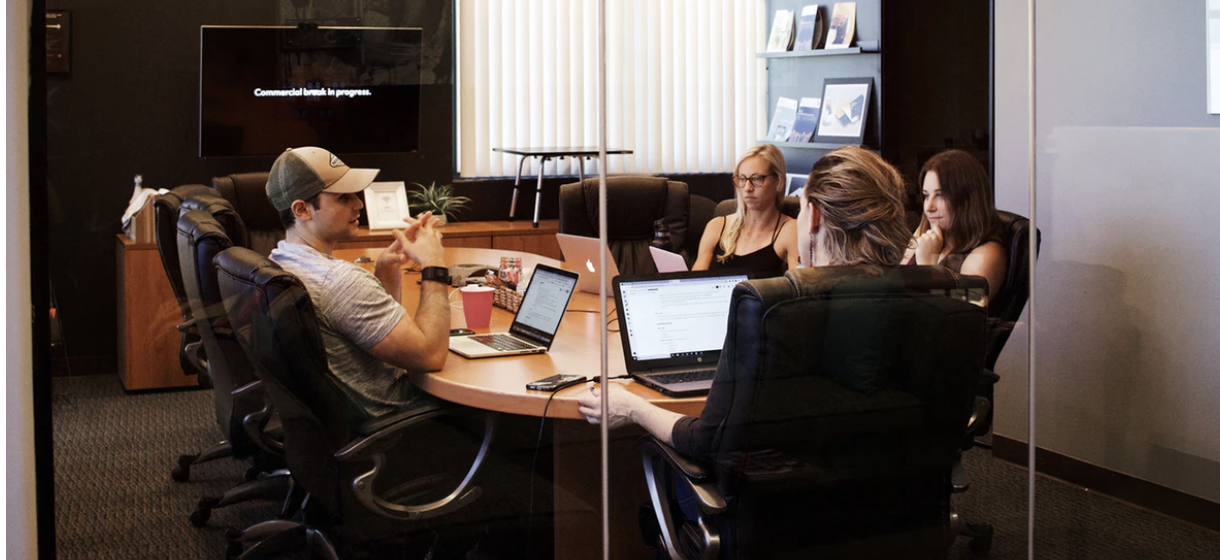
This project will provide valuable insight for leaders on how they personally impact workplace climate and also actionable EQ tools for learning how to improve their positive influence and impact. The project began with an OVS highlighting key challenges and opportunities in the climate. A key outcome was a clear need to advance leadership capabilities in a specific way to align to the corporate mission and also to generate a more positive, engaged climate.
Carolyn's Project
Project/initiative
Advancing Leadership:
Based on the theory that the quality of leadership has a direct impact on work climate which then has a direct impact on results, my project is designed to elevate the leadership capabilities of a small, fast growing company through emotional intelligence.
The audience is the top 75 people leaders in a 500 person company. And, the measurable goal is to shift Employee Engagement from 36% to over 50% within 6 months. No easy feat.
The company has a customer facing mission based related to empowering people and this initiative is designed to align the internal culture with the outside mission. When employees are engaged, motivated and enabled to grow and contribute at their best the company will be more equipped to deliver on its customer mission to empower people.
This project will provide valuable insight for leaders on how they personally impact climate and also actionable EQ tools for learning how to improve their positive influence and impact. The project began with an OVS highlighting key challenges and opportunities in the climate. A key outcome was a clear need to advance leadership capabilities in a specific way to align to the corporate mission and also to generate a more positive, engaged climate.
Each participant, starting with the executive team, will complete a 360 and coaching debrief. The Executive team will then come together and share their personal findings and discover their collective opportunity for driving climate change.
6 Leadership learning sessions based on elevating EQ will be delivered to provide a forum for leaders to explore and learn how to advance their impact and effectiveness in driving engagement, motivation and change.
By focusing on a large group of leaders, the project will provide the scale to generate a meaningful impact on climate. And, will have the secondary benefit of establishing a leadership code for the company (i.e., This is what great leadership looks like for us).
Why are you are doing this project?
The desired impact of this project is to create a significant shift in organizational climate towards and environment that is aligned with the company’s goals of empowering people to see, feel and claim their power. I believe that this work will have the following benefits:
- Empowering leaders to lead from the heart with a shift from command and control tactics to more effective coaching and collaborative styles.
- Elevating the experience of employees as the company becomes a place that more consistently provides the conditions for people to do their best work.
- Increasing engagement and trust to levels that will impact innovation and achievement of company goals.
- Creating a more human workplace where people learn, grow, do better work and are more fulfilled.
This work matters to me because my noble goal is to support people in living with more creativity and compassion. When workplaces are more human, civil, and compassionate people can access and their full creative and resourceful selves in the service or doing their best work. And when we work with more compassion and empathy we generate more openness and engagement.
How was MC for your growth?
The greatest benefit that I received from the MC process was the boost of inspiration from meeting incredible people from around the world who are doing really amazing, important work in this area.
The process provided me with structure and accountability that helped me see the bigger picture of the impact of the work that I am doing. And, generated more ideas for how to execute.
The MC experience has me thinking more systematically about my work – how all the pieces fit together. And has renewed my confidence in the great importance of this work. I also have an entirely new group of people to reach out to for advice, inspiration and collaboration.
About Carolyn:
Linked In : Carolyn Meacher

My MC project was to demonstrate to the executive team the business value of EQ by improving personal leadership and EQ of my coaching clients. In my HR work over the past two years, I’ve been feeling that while the business was growing fast, some people issues were ignored, which can be dangerous for the sustainability of organizational development.
Morgan's Project
Project/initiative
This project is part of my OD work, combined with others OD modules, such as strategic decoding, organization design, process optimization and incentives planning, to achieve business outcomes across the organization. Specific to this project, is the objective to improve personal leadership and/or emotional intelligence of the participants, and improve the team climate of the participating teams.
I want to help people who work in organizations as change makers, and are interested in improving individual and organizational performance in EQ way to achieve business outcomes. They want to know how to use the Six Seconds philosophies, models and tools to make change happen and make it ongoing successful. I hope they will gain and benefit from my reflections on the practice regarding project designing and implementing so that they might be more confident and thoughtful to deal with their own projects.
Communicate why you are doing this project
I work in a traditional manufacturing company, as a HR manager 2 years ago, and now an OD expert. OD is about changing the whole organization. The deeper I dive into this field, the louder a voice speaks that genuine change will never happen in an organization without each person’s inside change. This project will bring me resource and energy to make my OD work more solid, and I deeply believe that my individual clients will achieve desirable growth. In this project I’m able to act on my Noble Goal: Support positive transformation of individuals and organizations. This project is totally about transformation at individual and organizational level.
How was MC for your growth?
The MC process helped me and my project a lot in many ways. I was especially fond of the self-reflection and MC details survey, the SEI 360 assessment and debriefing, and the discussion on my project with other participants. All of these helped me to see the big picture of the project and the subtle signs inside my heart.
Being in MC was definitely extremely special. Starting a new day from the energizers provided by volunteers to awake bodies and minds, sharing personal stories in Heart Talk to build connection between each other, co-creating the topics and choosing freely to learn to absorb various of perspectives, mentoring or being mentored on your projects to concrete it, experiencing exotic local culture to relax, and ending the day with the parties together to have crazy fun…, every moment was unforgettable. Fantastic!
As for me, the laughs and tears nurtured the seeds of awareness, insights, reflections, connections and wishes, which will support my continuous growth for life long.
The change in my work as a result of MC has been simple but significant. I can do better at accepting and connecting with myself and the others.
The change inside made my work change a lot. One of my values is Courage. In the beginning, I supposed that my client could only be a few directors who are interested in EQ, and I hoped the positive change happened on them could convince the senior management to buy in EQ. That was pretty cautious. After MC, I decided to do something of more risks, and my adventure worked! 7 VPs, 6 pilot directors and their teams, plus dozens of directors who are not in the pilot teams were involved in the project. The project was updated!
About Morgan:
Supporting positive transformation of individuals and organizations is thrilling. It gifts me with the opportunity to polish my expertise in OD and EQ field – coaching, facilitating, training and consulting, to live my values – love, courage and wisdom. I’m grateful for being together with those who make a difference.
LinkedIn: https://www.linkedin.com/in/morgan-han-95080b105/

The project is to move Dragonfly’s curriculum from being EQ Competency-based to Talent-based outcomes. For many young people, there is an enormous amount of pressure placed upon them to achieve academically. This pressure comes from parents, teachers and themselves trying to “succeed” and not let others down.
Mike's Project
Project/initiative
The project is to change Dragonfly’s curriculum from being Competency-based to Talent-based. Primary audience is our students, people from International Schools, whose families come from all over the world, aged from 7-22 years in the main. Secondary audience is our staff, experienced educators from many different countries.
For many young people, there is an enormous amount of pressure placed upon them to achieve academically. This pressure comes from parents, teachers and themselves trying to “succeed” and not let others down.
This over-emphasis on the academic creates the situation where the “soft skills’ are neglected, especially in Asia where emotions are seen to be a weakness or something that holds you back and are very gender-specific, e.g. males should not be seen to be sad or vulnerable.
What we aim to do is to increase individual’s awareness of their emotions, help them to start to understand where these emotions come from, why they feel them and that it’s ok to feel however they feel.
Why are you are doing this project?
In the past we have encountered difficulties with some of the language and concepts and explaining these to clients, customers and staff. With our limited timeframe, making ideas simple and easy to connect and transfer into their day-to-day lives is crucial. The project aims to introduce easier language and connections.
We are looking to increase staff confidence that has come from a deeper understanding, client awareness and understanding, which leads to an increased ability to integrate into their lives and customer understanding which leads to enhanced trust with Dragonfly Ltd.
My Noble Goal: Opportunities to Experience Joy leads my work. I feel by making things simpler and easier to grasp then not only will staff be able to gain enhanced knowledge but also ability to help other experience and learn, subsequently our students will gain a deeper understanding and capacity to apply to their day-to-day lives, creating opportunities for them to realize the many opportunities each day to experience joy and build upon their own happiness.
How was MC for your growth?
By giving me freedom and helping me travel into the space of freedom to work, MC helped me go further in this process.
Having so many amazing, passionate people sharing knowledge, hints & tips, revitalized me, showed me other ways to look and think about what I am doing and want to do.
I have realized and understood different approaches, techniques and innate traits within me, and then utilizing those, rather than ‘copy-and-pasting’ from previous experiences, trainings and documents.
About Mike:
I started the education and training journey with coaching in sports then moved to teaching, before moving to education outside the classroom.
Believing that all experiences can help us develop, I have sought out these experiences by working in over a dozen countries. This has included working with corporations, universities and international schools.
Website: www.learnwithdragonfly.com
Facebook Page @learnwithdragonfly
Instagram: @learnwithdragonfly
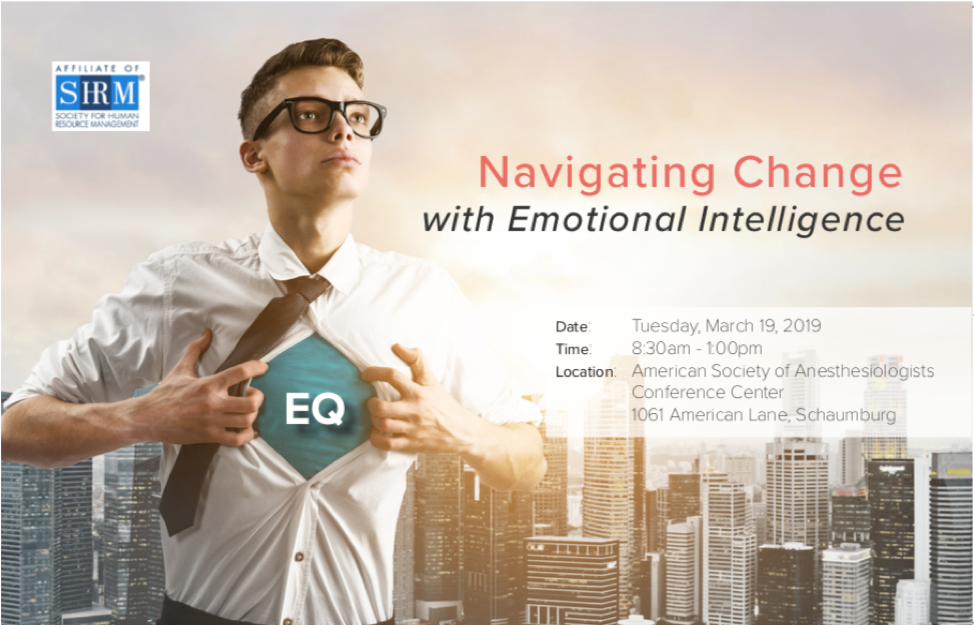
My Project was to develop a new presentation”Navigating Change” to expand my offerings to clients. is a highly interactive workshop where participants will leverage data from the SEI assessment to discover their patterns when reacting to change. The workshop uses a combination of self-discovery, small group activities, table discussions, and learning map activities to provide participants with tangible strategies to navigate change effectively.
Kelli's Project
Project/initiative
My audience includes all change makers within medium to large organizations. This includes OD, Talent Development, Change Management, Learning and Development, and Employee Engagement professionals.
Organizational change is never ending. And while it can be easy to recognize that change is needed, leaders quickly find out that change is less about the processes and more about the people. In fact, people drive change, and emotions drive people.
According to Dr. Kotter, a pioneer in the field of organizational change, successful large-scale change requires engaging not just the mind, but also the heart. In fact, in 1996 Kotter stated that 70% of change fails primarily due to the people side of change. Twenty plus years later, that percentage still holds true!
My project will help change leaders get to the 30% side of that equation by Navigating Change with Emotional Intelligence.
Navigating Change is a highly interactive workshop where participants will leverage data from the SEI assessment to discover their patterns when reacting to change. The workshop uses a combination of self-discovery, small group activities, table discussions, and learning map activities to provide participants with tangible strategies to navigate change effectively.
Upon completing this workshop, participants will be able to:
- Identify patterns related to their reactions to change
- Equip self and others with a three-step process to effectively respond to the challenges that come with change
- Practice the skills of Emotional Intelligence as a strategy to navigate change
Workshop registration includes:
- 5 SHRM credits
- Interactive, live workshop
- Six Seconds SEI assessment, taken prior to the workshop
- Personalized development plan
- Three-month access to THE PRACTICE™
- Two follow-up coaching sessions (optional)
Why are you are doing this project?
IMPACT ON CLIENTS: As an Organizational Development consultant I often see teams flounder with change. It seems like the pressures of time and a sense of urgency creates a mad dash to make change “happen.” My WHY is to create an opportunity for change makers to recognize the value in slowing down to connect with the people side of change to inspire a climate of engagement, connection, innovation, and drive throughout all levels of the organization.
IMPACT ON EQUIP STUDIOS: My hope is to introduce a program that individuals will want to bring back to their organizations. This program introduces EQ, the SEI Assessment, and provides an opportunity to engage in THE PRACTICE post training. My goal is to demonstrate the value and importance of focusing on EQ and using a practice methodology for building EQ skills.
My noble goal is to engage in authentic communication that inspires connection and belonging. This program aligns by facilitating the need to focus on the people side of organizational change.
How was MC for your growth?
I had the opportunity to review my project with my mentor, Natalie, and Josh. Both gave me some very practical feedback and guidance based on their own experiences. They were able to share their successes and failures to help me position my workshop. Patty, Michael, and Maria were also very helpful in how to market and position my workshop for open enrollment. I’m excited to implement the ideas I walked away with from the collaboration that occurred during the Masters program. I am definitely walking away feeling more confident in my strategy.
What was special about being in MC and what was the effect did that have on your growth?
Preparing for and sharing my Heart Talk really stretched me and helped me to better understand my own patterns at a deeper level. It pushed me to be vulnerable and admit my weaknesses.
Making new connections was also significant. These new relationships and connections have been very encouraging and life giving.
As a result of MC, I have been able to take significant steps to position and move THE PRACTICE forward.
About Kelli:
I am an Organizational Development professional with 25 years of experience unlocking infinite possibility. I enjoy working with organizations to design creative solutions to develop leaders, teams, and individual contributors.
I am a Professional Certified Coach with the International Coach Federation (ICF), a Certified EQ Assessor and Practitioner.
Website: www.EQuipStudios.net
Facebook age: https://www.facebook.com/EQcoaching.KelliSchulte
Twitter: @IcoachEQ
LinkedIn: https://www.linkedin.com/in/kellischulte/

My project is a 3-hour workshop for parents to what tantrums are, why do kids have it, some possible triggers, and effective strategies to reduce and manage them using emotional intelligence.
Vincent's Project
Project/initiative
PARENTING 101: MANAGING TANTRUMS USING EMOTIONAL INTELLIGENCE
In my 14 years of teaching I’ve dealt with a lot of very young kids where some as early as 3 years of age have been acting out in class, ignoring or defying teachers’ directions, or being too aggressive with other kids. I’ve been frequently asked by parents about how to manage problem behaviors or how to deal and respond effectively especially when “textbook” interventions don’t give positive results as expected. Though there is no “one-size-fits-all” approach but one thing is certain – these kids may have been exhibiting problem behavior for years before they start school.
This project is designed primarily for parents who are starting to lose grip on their kids – those who are starting to get depressed, questioning their own abilities and wondering where they’ve gone wrong or even those who are so stressed that they’re having trouble liking their kids. Second, this program favors those who have trouble taking action knowing that early intervention is the key but thinks that their kids will be “cured” by the natural order of things. Lastly, this initiative is for parents who are looking beyond therapy. Those who are seeking a life-long positive relationship with their kids and those around them – helping them avoid being labeled as “problem” kids. The earlier they can help their kids, the happier and more successful they’re going to be.
This parenting workshop is part of a series with the goal of empowering parents towards a more confident, consistent and effective parenting.
Why are you are doing this project?
Despite the tons of parenting and behavior management books out there, parents sometimes need more support and coaching than a recipe can provide due to the fact that some kids are just more prone to challenging behaviors, and tougher to manage, than others.
This project doesn’t give participants a script to read, memorize, internalize and execute things on your own. Rather, they will be immersed into practicing the EQ theory where they will be blending their thinking and feeling to solve their kids’ challenging behaviors, make optimal decisions, and make moments real for their kids. As a result, parents will give themselves as good examples. Kids believe more in what they see than what they hear. Whether participants are beginners or old-timers in the field of parenting, think of this process as a roadmap to calmer, more consistent ways to manage problem behaviors and an opportunity to gain new insights to help children develop and practice emotional intelligence early to regulate their own behaviors. This project provides a guide towards inspiring positive change – a noble goal that I’ve been pursuing that hopefully will allow parents to become more effective, consistent and confident especially in dealing problem behaviors.
How was MC for your growth?
When I was invited to join Masterclass 2018 in Koh Samui, I was elated because it was my first time to experience it and I was the only participant coming from the Philippines! True enough, I had an awesome experience learning and collaborating from the world’s greatest minds on emotional intelligence.
What was special about the Masterclass was the sharing of ideas and putting it into real-world action by passionate people around the world working to create meaningful change. Beyond slogans and posters, the Masterclass helped me define, shape, articulate, and activate my purpose and, bring more meaning the way I relate to my family and community. Picking up the skills, experience, and toughness of emotional intelligence enabled me to travel farther and achieve things better.
About Vincent:
Vincent is a designer. He believes that all people have the potential to succeed. His job is to see the potential in others, finds out what they lack to develop it, and equips them with what they need. Vincent loves to travel and learn by immersing himself in other cultures.
Facebook: https://www.facebook.com/vssoriano
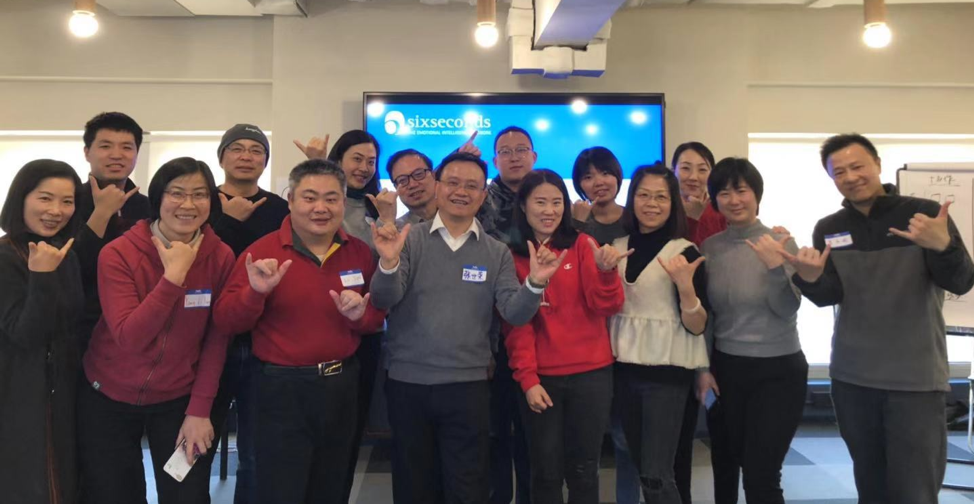
My project is about promoting Vital Signs in China. The target audience groups are corporate leaders, teams and organization. Chinese corporate users are consistently looking for trustworthy and proved methods/tools to help their individuals and team to achieve better performance results.
Leslie's Project
Project/initiative
My project is about promoting Vital Signs in China. The target audience groups are corporate leaders, teams and organizations.
Chinese corporate users are consistently looking for trustworthy and proved methods/tools to help their individuals and team to achieve better performance results.
Chinese corporate users will have chance to better understand the overview of the Vital Signs model, value of its usage to individual leaders, teams and organizations. Moreover, they will have an overall understanding of how to apply VS tools in a business context, through a real business case example.
Why are you are doing this project?
This project will create new opportunities for the clients to enjoy the comprehensive VS toolsets, including assessment tools, individual/team coaching, tailored workshops, thus to facilitate the clients have positive changes.
My Noble Goal is to promote wisdom, joy and love. I believe the VS and the related EQ competencies are the wisdom that are needed. And with the application of these tools, people have more chances to enjoy more peaceful joy and love.
How was MC for your growth?
This MC includes quite a lot of valuable experience and sharing work from experts all around the world, eg. I was very much impressed by the VS sharing sessions from north America, Asia and Italy teams. These sessions increased my motivations for the VS work and gave me more alternative activities to promote VS toolsets.
One thing special is the people of the MC. I can certainly feel their inside belief, passion and commitment of the EQ community. The connection that MC created among people will have long impact on my growth.
After MC, I am motivated to bring two sessions alive in China to re-experience the excitements, and thus built my capability and faith for the VS stuff. These activities received good feedback and created some fans from the audience, which I believe is a good start and will motivate me to continue the project further.
About Leslie:
I am Leslie Zhang from Shanghai. I was a management consultant for 16 years and now an EQ practitioner/facilitator for 3 years. My near-term goal is to promote EQ to 10,000 people before 2020. I am on the way for this exciting goal.

This MC project to finish Self-Science Curriculum, is aimed at teachers, parents, administrators in K-8 early elementary and middle school programs around the world. EQ is teachable and learnable. Both the instruction and exploration of emotional intelligence skills can and should be fun. Self Science is a collection of creative, engaging lessons that teach emotional intelligence competencies using brain-based methodology
Cherilyn's Project
Project/initiative
Self-Science 2018
EQ is teachable and learnable. Both the instruction and exploration of emotional intelligence skills can and should be fun. This project is aimed at teachers, parents, administrators in K-8 early elementary and middle school programs around the world. Self Science is a collection of creative, engaging lessons that teach emotional intelligence competencies using brain-based methodology
Why are you are doing this project?
This book will be the first kindergarten through grade 8 scope and sequence curriculum that Six Seconds has created around the eight EQ competencies.
My noble goal is “to awaken strengths for a harmonious world.” This project is a collaboration of many creative minds throughout the Six Seconds network: our Preferred Partners, Regional Network Directors, Board of Directors, and Global Office Team. In my role, I listened and noticed others’ strengths in curriculum design, and encouraged their contributions. What is more, the new Self-Science curriculum will promote peace within children, schools, and their larger communities.
How did the MC process help you grow?
The Master Class process gave me an avenue and a platform to share my project with some of the most dedicated members of our community. Convening with other educators around the dining table let me hear the joys and pains of global learning systems and reinforced for me the importance of creating access to Self-Science for as many children as possible. Many of my colleagues shared their concern about the increasing youth suicide rate. Rather than being simply “nice to have,” social emotional learning saves lives. from my colleagues, a fire under me to create outstanding lessons that not only introduced others to the EQ competencies, but also modeled our trademark methodology (Engage Activate Reflect).
My mentor and colleagues in the Education Master Class cohort had extensive knowledge of psychology, curriculum design, and social emotional learning. Moreover, the team shared powerful insights about how they strive to address SEL in their respective cultures.
A highlight of Master Class was watching many of the world’s foremost EQ practitioners come together to refuel one another’s noble goals. I was humbled by the diverse stories, projects, and expertise of the group. In particular, the contingent of well-established, successful female entrepreneurs provided me with many role models with whom I hope to connect in the future.
About Cherilyn
With over a decade of classroom experience, my goal is to integrate social emotional learning into all levels of education. I develop curriculum, assessments, and workshops about emotional intelligence competencies in my role as the Assistant Director of Education at the Six Seconds Global Office.
Facebook: https://www.facebook.com/cherilyn.gain
Twitter: @cherilynleet
LinkedIn: https://www.linkedin.com/in/cherilynleet
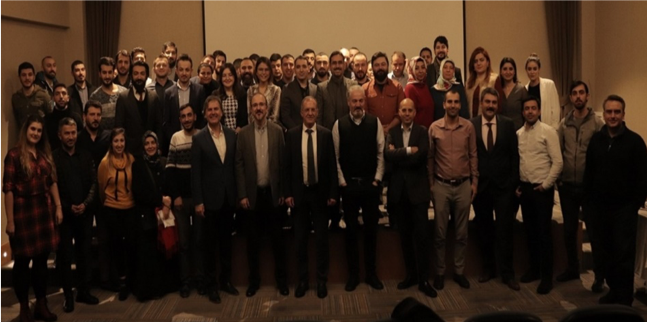
My project at MC is to develop my skills with Vital Signs Model & Tools and over this period to achieve my goal to becoming an even more efficient, competent consultant. Before MC, I started with a new client- Çizgi Technology. To better serve this client, I needed to develop knowledge, experience, model, tools, global practice, background.
Erdem's Project
Project/initiative:
Before MC, I started with a new client- Çizgi Technology- as a consultant in August 2018. I needed knowledge, experience, model, tools, global practice, background. So I decided to write my project about ‘Becoming an efficient, competent consultant by using Vital Signs Model & Tools and use this period to achieve my goal.
About the client: Çizgi Technology is an innovative company in industrial automation and IT products. It was founded to develop and produce high value-added products of advanced technology in 1994. With its own R&D team produces medical solutions, industrial panel PC, kiosks and Digital Signages. It has two founders whom have roles as vice presidents. There are totally 55 Blue+White workers, 11 managers in this flat organization.
As part of my project the owners of the company thinks a structural process should be established. Further they want to have a clear vision, focus areas for growth and clear goals. Also they need planning and envisioning, motivation, organizational clarity, clear job definitions and set the expectations. Besides clear and well-defined road map for improvement. In addition, the company needs more communication, teamwork, coordination. They need to work and celebrate their success together.
The company’s strategy and the structure of the organization will be clear by working with VS model. By using the LVS for founders and TVS for management team and some key responsible ones the improvement areas and a clear roadmap for corporate transformation will be defined. By working through a scientific model they will be able to follow the steps and monitor the process. So, this will help them to internalize the process. The necessary changes, investments and improvements will be done. People engagement will get stronger. The company will get – structural & relational wise- more productive, efficient and enjoyable work environment.
Why are you are doing this project?
Experiencing consulting on a scientific base with practical, global model and tools will give me learning and confidence. My brain style is visionary and I like to see the big picture. By VS model i am learning in every step to look at the big picture in a structural way and deliberate the process with the powerful tools supporting it. Working with the model and assessment is giving me the chance to blend my expertize for focusing on areas defined by the model. Most important one is working with VS model add me and my company a perception of trustworthiness, wise, global and experienced
First in the engage phase my client see the big picture clearly by the help of assessment and the model. They notice what is the situation. See what are the teams and leaders-the owners- strengths and weaknesses. Whole company understand the model and the reason of this transformation process. At the activate phase we deal with the needed areas which gives efficiency, focus and commitment. Setting the strategy and then manage the organizational, operational transformation and human resources side according to that vision. This creates trust to the process. At the reflection phase company can monitor how the transformation process going and what is needed to improve.
My Noble Goal is to create positive change on people and companies. Through the process the owners of the company, the management team and the other staff will benefit by working in an environment which is more productive, efficient and positive. I will reach to my goal by creating positive change in the company. My target is being a efficient, competent consultant. So this will get me closer to my target.
How was MC for your growth?
I was aware that The Vital Signs model offers a very clear and solid definition. The model gets me so focused. This leads my questions very to do point which makes them efficient. When they got to know about the model and realize the scientific background under it, they trust the process. Getting them aware of how important the trust is for their company was easier. Why, how and what questions were well defined. By the Change Map -Engage-Activate-Reflect manage the process better even in the hard times. By the support of assessment-LVS&TVS it became clearer where to improve. Emotional intelligence became one of a priority. Effort of understanding the people side of relations became one of an importance. The value of reflection was realized and used often.
Vital Signs workshops were fascinating. Learned useful, effective information about preparing proposals for consulting. Create personal contacts within the Six Seconds organization and got inspired and was impressed. I made valuable acquaintances from all around the world. Exchanging ideas was great. Focusing on Six Seconds Model & Tools in a beautiful environment enriched my knowledge. I gained motivation and energy and had a great fun. Full day program with different subjects and experts was an amazing experience. EQ talks which was motivated and impressed me was fabulous
The way I listen the client and the way I prepare the proposal has changed positively. MC process provided clear planning and follow up. I learned a lot about Vital Signs in my de brief of Leadership Vital Sign assessment, classwork and project. I have also enlarged my knowledge base, experienced new training tools, engaged with the partners and members of Six Seconds. My Six Seconds journey has deepened as a result of MC. All these positive changes on me directly effect my business positively.
About Erdem:
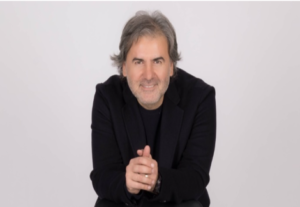 I am a PCC credential Executive & Team Coach, Trainer, Consultant and Keynote Speaker. Founder of Hayatin Ritmi -Preferred Partner of Six Seconds for 3 years- which is delivering services in those areas. Tango dancer who has an ICF approved training ‘Tango&Coaching’. Married, has a 2 years old son.
I am a PCC credential Executive & Team Coach, Trainer, Consultant and Keynote Speaker. Founder of Hayatin Ritmi -Preferred Partner of Six Seconds for 3 years- which is delivering services in those areas. Tango dancer who has an ICF approved training ‘Tango&Coaching’. Married, has a 2 years old son.
Website: www.erdemercan.com
Facebook Page: erdemercanofficial
Twitter: eercanofficial
LinkedIn: erdemercanofficial
Instagram: erdemercanofficial
Youtube: Erdem Ercan

I wanted to refine templates for Six Seconds web content and generate wider global perspective for our audience.
Michael's Project
Project/initiative
My audience is Six Seconds’ leads and clients who receive communications from us in the form of articles and emails. They are people who have already indicated an interest in emotional intelligence. What they gain from the project is more clarity about what steps they can take to be more involved with EQ and Six Seconds.
Why are you are doing this project?
I wanted to clarify how to move forward and engage with our wide variety of products and services. Ultimately, this helps our certified network practice emotional intelligence and improve their quality of life. This aligns perfectly with my Noble Goal, which is to Inspire others to see life as a miracle.
How was MC for your growth?
The MC process was invaluable in just giving me some time and space to zoom out and focus on the bigger picture. I wanted to change the templates and simplify my processes for a long time, but it seemed I never had the time because I was too busy creating and sending the content. MC also inspired me because of the opportunity of connecting with so many amazing people. It would be hard to quantity how much enthusiasm and passion that connection gives me to do this work. I am a happier, more productive person and employee as a result.
About Michael:
I am a Senior Content Manager at Six Seconds. When I am not writing about emotional intelligence, I am probably enjoying the outdoors – farming, hiking, or riding my bike.

In my MC project, I wanted to develop more community and more connection amongst members of Six Seconds APAC region.
Lize's Project
Project/initiative
My audience is the members of our Network in the Middle East, Africa and India region. I’m looking at Six Seconds Certified members in our Network as well as Network Leaders for 2019. They will gain a sense of community from this project as I reach out to connect with them.
Why are you are doing this project?
The impact that this project will have on my work is that it will enable me to stay more connected with more of the network and enable them to stay more connected and build more community within the Six Seconds Middle East, Africa and India region. My clients will feel more connection and be able to share more with me and others among the certified network. We all crave connection and my humble efforts I hope will help fulfill this need. This work aligns very much with my Noble Goal which is to understand, to support and to be there for myself and others. I believe I’m better able to support and understand when I’m more connected and have a better sense of community with the Network Leaders and the Certified in our region.
How was MC for your growth?
I think through the process of MC and reflecting on my goal and listening to other people’s goals and having discussions it clarified a lot of things for me that I think otherwise would have remained unclear.
The connection and sense of community at MC was definitely inspirational. Thinking how we are all playing our part in something bigger. This sense of connection and community that I experienced is something I want to recreate for members of our network. Maybe not on such an intense scale as what we shared in MC but definitely a version of that.
I have become re-inspired and re-energized as a result of MC. Sometimes we get lost in the doing and at masterclass it was much for about the being and deciding how I want to be moving forward. So, the way I am and the way I work has changed.
About Lize:
I’m an educator and coach. EQ has changed the way I live my life and connect with people. I’d like to share that experience with others.

My initiative was to create an new business venture: New Futures Project: Creating Pathways of Energy and Clarity for People Towards Hope and Success
Amanda M's Project
Project/initiative
New Futures Project: Creating Pathways of Energy and Clarity for People Towards Hope and Success
I wanted to create this new opportunity for three key reasons: adapting to change, managing the transition from Singapore to Australia, and to develop a business model that takes us forward and sustains us professionally and financially in the future in South Australia. Central to this works is my Nobel Goal: “Support people through suffering.”
The vision of the project is to bring about whole hearted change for individuals and families towards a more holistic and happy life. We will be a retreat center with offerings in Wilderness Therapy, with retreats for parents and children.
In ten years time I would like this project to have achieved:
- Flexible business working from Adelaide with consultancy work both online and in person. Can be managed from France also via technology.
- Hearing: positive appreciation of the work we do, recommendations and testimonials that validate our service
- Seeing: happy clients with repeat business
- Regular work with financial income and security
